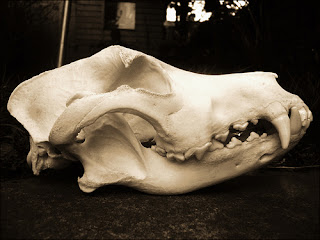The Boxer - a beautifull, boisterous and clown-natured breed, so well-known for it's appearance of having 'run into a brick wall'. These dogs have been around in this particular body type for centuries, however, the severity of the shortness of the muzzle has not. In fact, when the breed originally began, these dogs had the large, square muzzle of a mastiff. Unfortunately over the years, this feature has been altered by selective breeding - at first it created a shapely head, but eventually went to the extreme. These modern examples are beautiful in shape and outline, but the truth of the matter is that this facial feature poses serious health risks. And it is being passed on to generations.
Take note of the steepness of the above dog's stop. (The meeting of the muzzle with the head.) The eyes are literally in the front of the face, and the nose situated just below. From the front, this dog looks all cute and wrinkly, but a side view shows how squished the skull is. To prove my point, just below is the muzzle of a Saarloos Wolfdog - very closely related to the Grey Wolf, dog's ancestor. Through huge amounts of selective breeding, dogs have changed immensly.
Now for the real truth - beyond all those adorable folds of skin and dewlap, is the skull. This has been moulded so much in brachycephalic breeds that the difference is astonishing.
Above is the skull of a brachycephalic breed, most likely a Pug or British Bulldog. Notice the length (or lack of it) of the dog's nasal passages. Because these passages are so short and the nose pushed into the face, these dogs can have serious breathing difficulties and these passages often cause objects to become obstructed easily.
Also notice the bottom jaw; the teeth are nowhere near meeting. This is known as an 'undershot' jaw, and is a serious problem for any dog as it causes difficulty eating, chewing and even breathing.
Above also, is the skull of a German Shepherd. Similar in size and build to the wolf, this skull shows all the natural attributes of the dog's head from centuries back. The stop is well defined, the air passeges long, noise pointed and at the tip of the muzzle. Obviously, these dogs also have a better sense of smell to those flatter-faced Pugs.
As for the jaw and teeth, these meet perfectly in what is known as a 'scissor' bite, enabling easy chewing and breathing.
Now that these differences are pointed out, it makes sense to lessen the degree of 'flat' that is required by breed standards for these dogs.
The real, real issues behind the nose is the severity of breathing issues that these dogs are either born with or are afflicted with throughout life. It is quite common to see a brachycephalic dog panting with it's whole mouth open in an attempt to breathe - when these dogs overheat they cannot breathe through their small noses, which poses a huge suffocation risk - hence why these breeds do not cope well with excessive amounts of intense exercise.
While these breeds are loving, have fantastic personalities and are, of course, adorable, sometimes it is perhaps worth the time to think what strife we may be causing our pets in, say, 20 years time. Will this exaggerated muzzle be even more overdone? Or will dogs be returned to a more natural and healthly appearance?
Please note - this topic is intented as means of informing, not to offend or disagree with owners and breeders of these particular dogs. Yes, they are often great looking dogs, and do appear to live mostly normal doggy lives - I myself have a fondness for Boxers and Pointers - however, the point I am making is that this severity of the facial features was never natural, so is it really what we should want for our dogs?
The face of happiness - a mongrel in every form, theses dogs are rarely afflicted by breed-specific illnessess.





